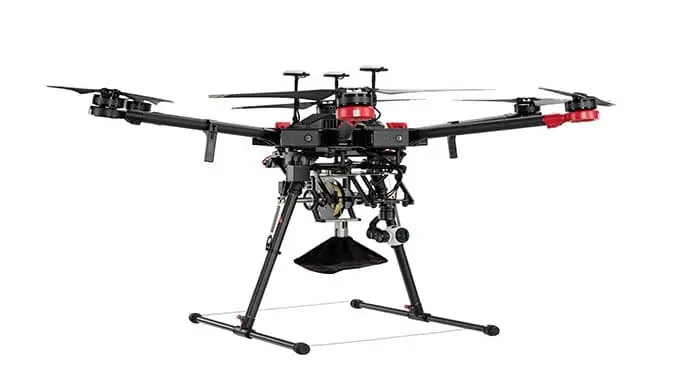
A2Z Drone Delivery has launched the RDS1 (Rapid Delivery System), a tethered freefall drone delivery mechanism available as an add-on or as part of a ready-to-fly UAS (unmanned aerial system) based on the DJI Matrice 600 Pro. Designed to deliver payloads up to 2 kg (4.4 lbs.) from a safe hover of up to 150 feet (45.71 meters), the RDS1 is ideal for rapid deployment of time-sensitive first aid and life-saving medical supplies, or for situations where landing a drone is extremely difficult, such as moving vessels or in dense forest.
By delivering payloads from a safe hover altitude, the RDS1 protects recipients from spinning drone propellers, while mitigating concerns of low-flying drones breaching privacy as well as intrusive rotor noise. The unique freefall delivery mechanism reduces time-on-station to ensure onboard power can be put to use in other ways. Built on the familiar DJI flight control interface, the A2Z Drone Delivery app combines manual control system operations with an onboard sensor array to manage the package’s freefall and gently stop its descent just above the ground. Rated at 100 lbs. tensile strength, the RDS1’s Kevlar tether and elastic fabric pouch can be reeled back up for reuse or to retrieve materials from personnel on the ground.
The RDS1 delivery mechanism incorporates a LiDAR sensing system that streams continuous data to onboard firmware which controls the payload’s rapid descent. Other key features include:
Payload status detection – Monitors payload throughout flight and delivery, enabling eventual beyond-visual-line-of-sight (BVLOS) missions
Pre-flight weight check – Ensures the flight platform is not overloaded and controls payload deceleration
Rapid descent calculation – Automatically determines when to slow the payload freefall at the proper distance from the ground
Manual delivery control – Intelligent onboard systems provide safeguards while allowing pilots to manually control tethered payload delivery and retrieval
Emergency payload abandonment – Allows the pilot to quickly detach the drone from its payload amid flight emergencies
Transverse tether winding – Ensures the tether is tightly woven on the reel to maximize capacity and prevent knotting
Passive payload lock – Safeguards against payload loss or tether slippage in case of unforeseen power fluctuations, and eliminates the need for additional payload housing
In either the modular add-on or full UAS configuration, the RDS1 also includes A2Z’s Drone Delivery App, which incorporates intuitive overlays on the familiar DJI flight control interface, allowing pilots to monitor payload status while manually controlling delivery and retrieval.
Aaron Zhang, founder of A2Z Drone Delivery, commented: “Our rapid delivery system is ideal for situations where a drone cannot safely approach close proximity to its delivery location such as delivering radios or medical supplies to a search and rescue team in a forest or as a more efficient option to deliver and retrieve port documents from awaiting cargo ships. While other drone delivery platforms are designed to hover close to the ground, our tethered free-fall delivery technique enables efficient and accurate placement without the UAV approaching people, structures or other obstructions like trees and wires.”
“As we bring this first iteration of our unique rapid delivery system to market, we’re eager to work with our customers to adapt the system to meet their unique mission demands and set our product roadmap to suit their needs. We have already initiated development of a ‘tap-and-go’ payload auto-release mechanism to remotely deposit the payload without an awaiting recipient; and while our flexible payload pouches can already accommodate diverse demands, our design team is nimble enough to adapt the delivery system to just about any payload the flight platform can support.”


















